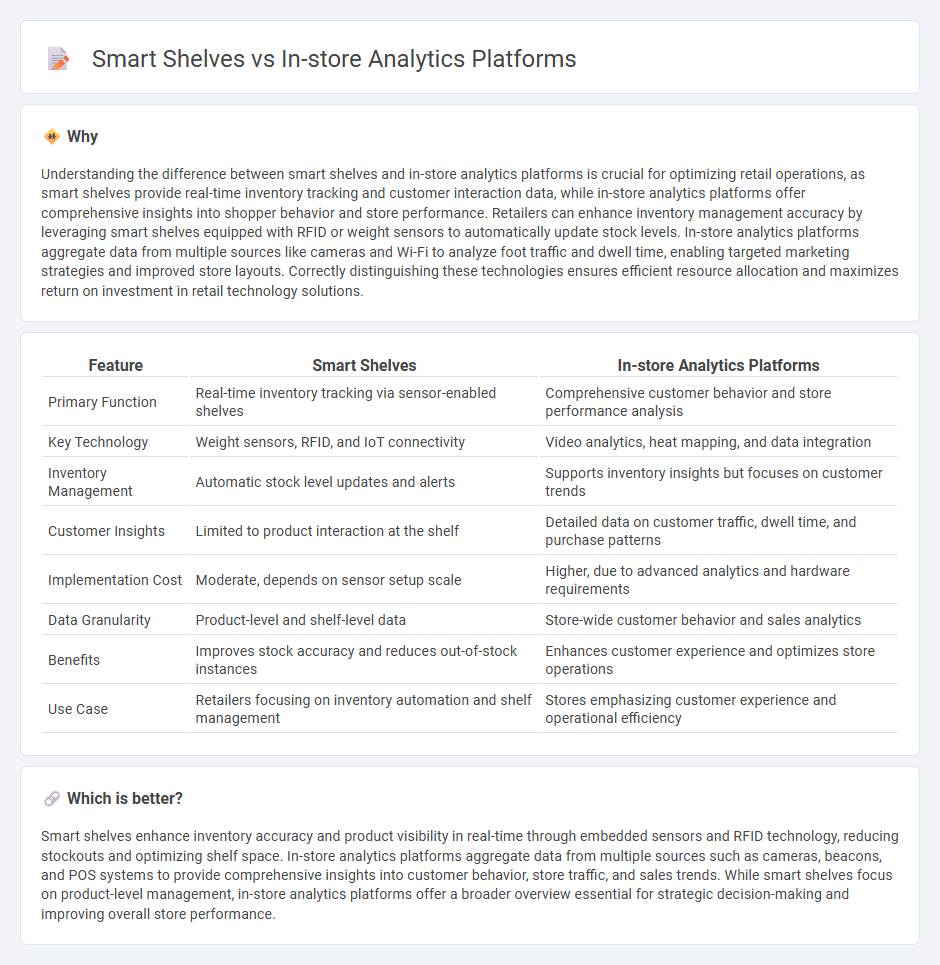
Smart shelves use embedded sensors and RFID technology to monitor inventory levels in real-time, enhancing stock accuracy and reducing out-of-stock scenarios. In-store analytics platforms leverage data from multiple sources such as cameras and Wi-Fi to analyze customer behavior and optimize store layouts, improving shopper experience and sales performance. Discover how integrating these innovations can transform retail operations and boost profitability.
Why it is important
Understanding the difference between smart shelves and in-store analytics platforms is crucial for optimizing retail operations, as smart shelves provide real-time inventory tracking and customer interaction data, while in-store analytics platforms offer comprehensive insights into shopper behavior and store performance. Retailers can enhance inventory management accuracy by leveraging smart shelves equipped with RFID or weight sensors to automatically update stock levels. In-store analytics platforms aggregate data from multiple sources like cameras and Wi-Fi to analyze foot traffic and dwell time, enabling targeted marketing strategies and improved store layouts. Correctly distinguishing these technologies ensures efficient resource allocation and maximizes return on investment in retail technology solutions.
Comparison Table
| Feature | Smart Shelves | In-store Analytics Platforms |
|---|---|---|
| Primary Function | Real-time inventory tracking via sensor-enabled shelves | Comprehensive customer behavior and store performance analysis |
| Key Technology | Weight sensors, RFID, and IoT connectivity | Video analytics, heat mapping, and data integration |
| Inventory Management | Automatic stock level updates and alerts | Supports inventory insights but focuses on customer trends |
| Customer Insights | Limited to product interaction at the shelf | Detailed data on customer traffic, dwell time, and purchase patterns |
| Implementation Cost | Moderate, depends on sensor setup scale | Higher, due to advanced analytics and hardware requirements |
| Data Granularity | Product-level and shelf-level data | Store-wide customer behavior and sales analytics |
| Benefits | Improves stock accuracy and reduces out-of-stock instances | Enhances customer experience and optimizes store operations |
| Use Case | Retailers focusing on inventory automation and shelf management | Stores emphasizing customer experience and operational efficiency |
Which is better?
Smart shelves enhance inventory accuracy and product visibility in real-time through embedded sensors and RFID technology, reducing stockouts and optimizing shelf space. In-store analytics platforms aggregate data from multiple sources such as cameras, beacons, and POS systems to provide comprehensive insights into customer behavior, store traffic, and sales trends. While smart shelves focus on product-level management, in-store analytics platforms offer a broader overview essential for strategic decision-making and improving overall store performance.
Connection
Smart shelves utilize sensors and RFID technology to track product inventory and customer interactions in real time, feeding data into in-store analytics platforms for comprehensive analysis. These platforms aggregate and interpret the data to optimize stock levels, personalize marketing strategies, and improve store layout for enhanced shopper experience. The integration of smart shelves with in-store analytics enables retailers to make data-driven decisions that increase operational efficiency and boost sales performance.
Key Terms
**In-store Analytics Platforms:**
In-store Analytics Platforms leverage data from multiple touchpoints such as foot traffic, dwell time, and purchase behavior to deliver actionable insights that optimize store layouts and marketing strategies. These platforms integrate advanced technologies including AI-driven video analytics, IoT sensors, and real-time data processing to enhance retail performance and customer experience. Explore the cutting-edge features and benefits of In-store Analytics Platforms to revolutionize your retail operations.
Foot Traffic
In-store analytics platforms track foot traffic patterns using advanced sensors and AI-powered video analytics, providing detailed insights into customer behavior and store performance. Smart shelves complement this by monitoring product interactions and stock levels in real time, enhancing inventory management and personalized marketing efforts. Discover how integrating these technologies can revolutionize retail strategies and maximize sales potential.
Customer Dwell Time
In-store analytics platforms leverage sensors and cameras to track customer dwell time, analyzing how long shoppers spend in specific store areas to optimize layout and product placement. Smart shelves use embedded weight sensors and RFID technology to monitor real-time customer interaction with products, providing precise data on engagement and dwell time at the shelf level. Explore deeper insights into how these technologies transform retail strategies and enhance customer experience.
Source and External Links
14 Best Retail Analytics Software Solutions 2025 - Highlights major in-store analytics platforms like Shopify Analytics, Looker, ThoughtSpot, and NetSuite offering real-time dashboards, AI-driven insights, and integrated retail data management ideal for various retail sizes and needs.
Retail Analytics Software: Top Picks & Use Cases (2025) - Details how Shopify Analytics and Looker provide comprehensive in-store and ecommerce analytics with features like customizable dashboards, real-time insights, and AI-assisted reporting to optimize retail performance.
The 12 Top Retail Analytics Companies in 2024 - Reviews specialized platforms such as eSite Analytics and RetailNext, focused on in-store behavior tracking, inventory optimization, and enhancing customer experience through advanced retail analytics tools.
 dowidth.com
dowidth.com